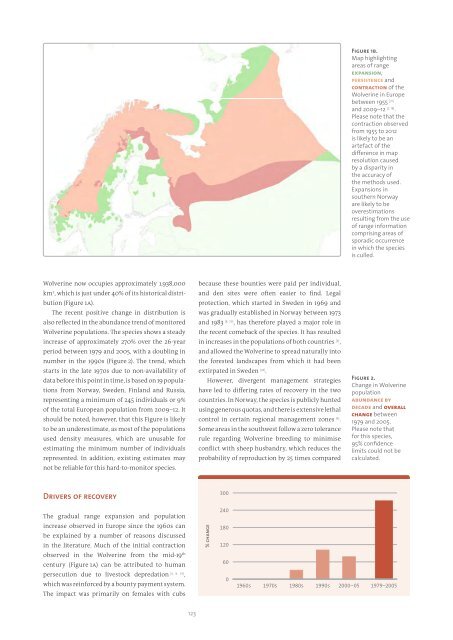130925-studie-wildlife-comeback-in-europe
You also want an ePaper? Increase the reach of your titles
YUMPU automatically turns print PDFs into web optimized ePapers that Google loves.
Figure 1b.<br />
Map highlight<strong>in</strong>g<br />
areas of range<br />
expansion,<br />
persistence and<br />
contraction of the<br />
Wolver<strong>in</strong>e <strong>in</strong> Europe<br />
between 1955 [31]<br />
and 2009–12 [2, 18] .<br />
Please note that the<br />
contraction observed<br />
from 1955 to 2012<br />
is likely to be an<br />
artefact of the<br />
difference <strong>in</strong> map<br />
resolution caused<br />
by a disparity <strong>in</strong><br />
the accuracy of<br />
the methods used.<br />
Expansions <strong>in</strong><br />
southern Norway<br />
are likely to be<br />
overestimations<br />
result<strong>in</strong>g from the use<br />
of range <strong>in</strong>formation<br />
compris<strong>in</strong>g areas of<br />
sporadic occurrence<br />
<strong>in</strong> which the species<br />
is culled.<br />
Wolver<strong>in</strong>e now occupies approximately 1,938,000<br />
km 2 , which is just under 40% of its historical distribution<br />
(Figure 1a).<br />
The recent positive change <strong>in</strong> distribution is<br />
also reflected <strong>in</strong> the abundance trend of monitored<br />
Wolver<strong>in</strong>e populations. The species shows a steady<br />
<strong>in</strong>crease of approximately 270% over the 26-year<br />
period between 1979 and 2005, with a doubl<strong>in</strong>g <strong>in</strong><br />
number <strong>in</strong> the 1990s (Figure 2). The trend, which<br />
starts <strong>in</strong> the late 1970s due to non-availability of<br />
data before this po<strong>in</strong>t <strong>in</strong> time, is based on 19 populations<br />
from Norway, Sweden, F<strong>in</strong>land and Russia,<br />
represent<strong>in</strong>g a m<strong>in</strong>imum of 245 <strong>in</strong>dividuals or 9%<br />
of the total European population from 2009–12. It<br />
should be noted, however, that this Figure is likely<br />
to be an underestimate, as most of the populations<br />
used density measures, which are unusable for<br />
estimat<strong>in</strong>g the m<strong>in</strong>imum number of <strong>in</strong>dividuals<br />
represented. In addition, exist<strong>in</strong>g estimates may<br />
not be reliable for this hard-to-monitor species.<br />
because these bounties were paid per <strong>in</strong>dividual,<br />
and den sites were often easier to f<strong>in</strong>d. Legal<br />
protection, which started <strong>in</strong> Sweden <strong>in</strong> 1969 and<br />
was gradually established <strong>in</strong> Norway between 1973<br />
and 1983 [8, 29] , has therefore played a major role <strong>in</strong><br />
the recent <strong>comeback</strong> of the species. It has resulted<br />
<strong>in</strong> <strong>in</strong>creases <strong>in</strong> the populations of both countries [8] ,<br />
and allowed the Wolver<strong>in</strong>e to spread naturally <strong>in</strong>to<br />
the forested landscapes from which it had been<br />
extirpated <strong>in</strong> Sweden [28] .<br />
However, divergent management strategies<br />
have led to differ<strong>in</strong>g rates of recovery <strong>in</strong> the two<br />
countries. In Norway, the species is publicly hunted<br />
us<strong>in</strong>g generous quotas, and there is extensive lethal<br />
control <strong>in</strong> certa<strong>in</strong> regional management zones [4] .<br />
Some areas <strong>in</strong> the southwest follow a zero tolerance<br />
rule regard<strong>in</strong>g Wolver<strong>in</strong>e breed<strong>in</strong>g to m<strong>in</strong>imise<br />
conflict with sheep husbandry, which reduces the<br />
probability of reproduction by 25 times compared<br />
Figure 2.<br />
Change <strong>in</strong> Wolver<strong>in</strong>e<br />
population<br />
abundance by<br />
decade and overall<br />
change between<br />
1979 and 2005.<br />
Please note that<br />
for this species,<br />
95% confidence<br />
limits could not be<br />
calculated.<br />
Drivers of recovery<br />
300<br />
The gradual range expansion and population<br />
<strong>in</strong>crease observed <strong>in</strong> Europe s<strong>in</strong>ce the 1960s can<br />
be expla<strong>in</strong>ed by a number of reasons discussed<br />
<strong>in</strong> the literature. Much of the <strong>in</strong>itial contraction<br />
observed <strong>in</strong> the Wolver<strong>in</strong>e from the mid-19 th<br />
century (Figure 1a) can be attributed to human<br />
persecution due to livestock depredation [4, 8, 29] ,<br />
which was re<strong>in</strong>forced by a bounty payment system.<br />
The impact was primarily on females with cubs<br />
% change<br />
240<br />
180<br />
120<br />
60<br />
0<br />
1960s 1970s 1980s 1990s 2000–05 1979–2005<br />
123


